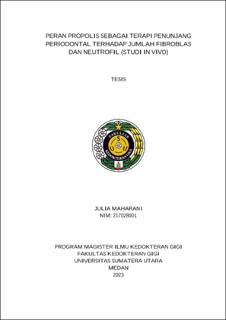| dc.description.abstract | Backgound: Periodontitis is an oral disease caused by the accumulation of dental plaque which can develop over time resulting in bacterial dysbiosis, periodontal pocket formation, gingival recession, tissue damage, and alveolar bone loss, which in turn can lead to tooth loss. Fibroblasts are connective tissue cells that function as defense because of their ability to differentiate into odontoblast cells and produce collagen fibers in the healing process. Neutrophils are very involved in the pathogenesis of periodontitis where neutrophils represent the majority type of leukocytes (≥95%) which are deployed to the gingival crevicular and periodontal pockets and can experience dysregulation in periodontitis conditions. Propolis has therapeutic properties derived from the content of secondary metabolites to accelerate the healing of periodontitis. Aim: This study was aimed to analyze the effectiveness of propolis extract gel as a periodontal support therapy on the number of fibroblasts and neutrophils in periodontitis. Methods: This study used 50 periodontitis-induced Wistar rats, which were divided into 5 treatment goups, and applied propolis extract gel with concentrations of 50%, 60%, and 70%, metronidazole gel, and placebo gel. The number of fibroblast cells and neutrophil cells was observed by taking the gingival tissue on the 3rd and 7th days which were observed by Hematoxylin-eosin histological staining. Results: The application of propolis extract gel as a supporting therapy for periodontitis has a role in the healing of periodontitis which was evaluated from a histological aspect, namely an increase in the number of fibroblast cells and a decrease in neutrophil cells on the 7th day in the in vivo study. Propolis extract gel had a significant mean difference in the number of fibroblasts on day 3 (p<0.05), but there was no significant difference on day 7. Propolis extract gel had a significant difference in mean neutrophil count on day 3 (p<0.05), but there was no significant difference on day 7. Propolis extract gel 50%, 60%, and 70% increased the number of fibroblast cells on day 7, with the highest increase in the number of fibroblasts at a concentration of 70%. Propolis extract gel 50%, 60%, and 70% reduced the number of neutrophil cells on day 7, with the highest decrease in neutrophil count at a concentration of 70%. Conclusion: 70% propolis extract gel has the best effectiveness in increasing the number of fibroblast cells and reducing neutrophil cells as a periodontal support therapy to accelerate the healing of periodontitis. | en_US |


